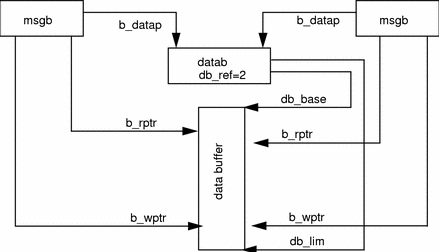Shared Data
In Figure 7-4, two message blocks are shown pointing to one data block. db_ref indicates that there are two references (mblks) to the data block. db_base and db_lim point to an address range in the data buffer. The b_rptr and b_wptr of both message blocks must fall within the assigned range specified by the data block.
Figure 7-4 Shared Data Block

Data blocks are shared using utility routines (see dupmsg(9F) or dupb(9F)). STREAMS maintains a count of the message blocks sharing a data block in the db_ref field.
These two mblks share the same data and datablock. If a module changes the contents of the data or message type, it is visible to the owner of the message block.
When modifying data contained in the dblk or data buffer, if the reference count of the message is greater than one, the module should copy the message using copymsg(9F), free the duplicated message, and then change the appropriate data.
STREAMS provides utility routines and macros (identified in Appendix B "STREAMS Utilities"), to assist in managing messages and message queues, and in other areas of module and driver development. Always use utility routines to operate on a message queue or to free or allocate messages. If messages are manipulated in the queue without using the STREAMS utilities, the message ordering can become confused and cause inconsistent results.
Not adhering to the DDI/DKI can result in panics and system crashes.
- © 2010, Oracle Corporation and/or its affiliates
